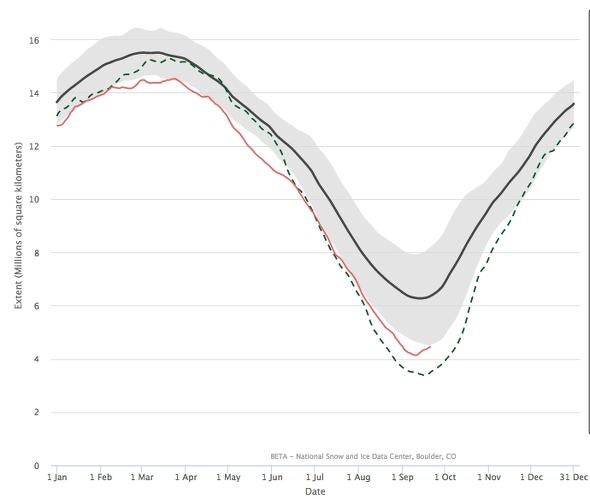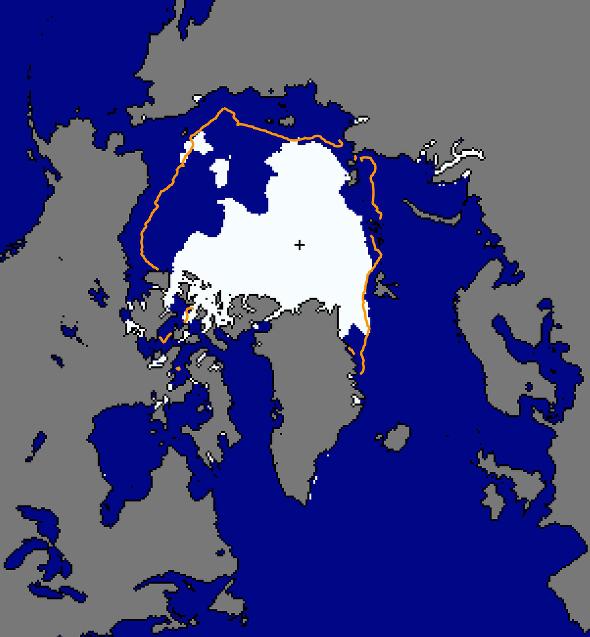Some records are best not broken. Especially when it’s the record for least amount of Arctic ice remaining after a summer of melting.
So it’s good that 2016 did not break that record. But when you look more carefully, you’ll find that’s hardly a relief.
The Earth’s boreal ice cap melts every summer as our planet’s North Pole tips toward the Sun in spring. The days get longer, the Sun gets higher, and the increased warmth melts the ice. This is a natural cycle and has been going on for a long time. In general, September of every year is when the ice reaches lowest amount.
This year, 2016, the ice reached its lowest extent* on Sept. 10. On that day, it had an extent of 4.14 million square kilometers, or about half the area of the contiguous United States. That’s very low. So low, in fact that it’s the second lowest extent ever measured, in a dead tie with 2007.
The all-time record low measured extent was in 2012, which was 3.41 million square km. But there are a couple of important things to note here.
One is that 2012 was very unusual. A dam made of ice in northern Canada broke, allowing warm water to mix with the Arctic ice, melting the ice far more than usual. That, at least in part, is what led to the record low extent of that year.
2016 had no such anomaly that is known. In other words, we just hit the second lowest amount of ice ever seen, and nothing unusual caused it.
Well, unless you don’t count fierce global warming as unusual. Sadly, it is the new normal.

NSIDC
The other thing to note is that all these records have occurred very recently. That too is because our planet is heating up. Every year we get just a bit hotter, and more records fall (in fact, as you’d expect, far more high temperature records are broken than lows). The record in 2012 has stood because it was caused by global warming plus more rare events like the ice dam breaking. But every year we get a bit hotter, and soon we won’t need those unusual events to break 2012’s record.
So I don’t expect 2012 to hold on to its status much longer. Arctic ice is in a death spiral, and it won’t be long (even on a human timescale) before we get an ice-free summer. Most predictions put that event in the mid-2040s. Even now, enough ice melts every summer to allow ships to ply the Northwest Passage.
Mind you, the Arctic still did break a record this year: It had the lowest maximum extent back in March. Every year in winter the water freezes, reaching its maximum area in early spring. When you compare the area at maximum extent over the years, that’s dropping too.
Not only that, but as Tamino points out at the blog Open Mind, 2016 is on its way to having the lowest average annual extent ever measured as well. Having the smallest maximum and near-record minimum makes that one pretty easy to understand.
This is all important because the difference in temperature between the poles and the equator drives much of Earth’s weather patterns. Warm water from the equator flows toward the poles, cools, sinks down into the oceans, then flows back to the equator to start the cycle again. This conveyor belt of heat is thought to help power the jet stream. As the poles warm, the difference in temperature across the latitudes shrinks. This weakens the jet stream, letting cold air from the Arctic drop down, bringing those “polar vortices” and their frigid temperatures into the U.S.
So yes, you can get colder weather with more global warming. An ice-free Arctic means a lot more than just easy passage across the northern Canadian ocean. It means a destabilization of the delicate balance of our water, atmosphere, and land, disrupting everything.
As I now point out every time I write an article like this, not all is lost. But we cannot do anything until we get politicians to at the very least recognize the danger we are in. Too many do not, flatly denying the science acknowledged and understood by the vast majority of climatologists.
The first step we need to take is vote those people out. Your voice matters. Vote.
*“Extent” is technical term that is more or less equal to the area covered by ice; scientists divide the Arctic into bins, and a given bin is said to have ice if more than 15 percent of it is frozen.
